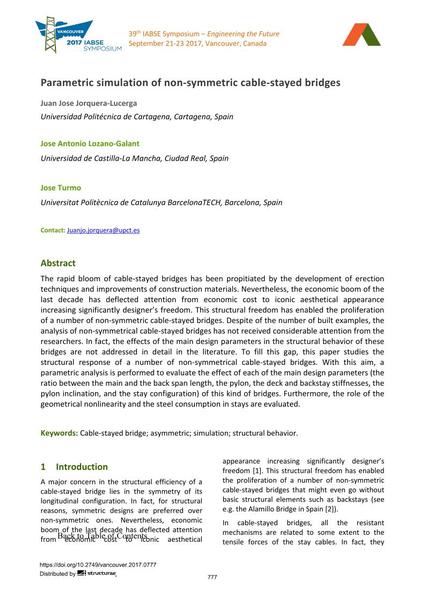Parametric simulation of non-symmetric cable-stayed bridges

|
|
|||||||||||
Bibliografische Angaben
| Autor(en): |
Juan José Jorquera-Lucerga
(Universidad Politécnica de Cartagena, Cartagena, Spain)
Jose Antonio Lozano-Galant José Turmo |
||||
|---|---|---|---|---|---|
| Medium: | Tagungsbeitrag | ||||
| Sprache(n): | Englisch | ||||
| Tagung: | IABSE Symposium: Engineering the Future, Vancouver, Canada, 21-23 September 2017 | ||||
| Veröffentlicht in: | IABSE Symposium Vancouver 2017 | ||||
|
|||||
| Seite(n): | 777-784 | ||||
| Anzahl der Seiten (im PDF): | 8 | ||||
| Jahr: | 2017 | ||||
| DOI: | 10.2749/vancouver.2017.0777 | ||||
| Abstrakt: |
The rapid bloom of cable-stayed bridges has been propitiated by the development of erection techniques and improvements of construction materials. Nevertheless, the economic boom of the last decade has deflected attention from economic cost to iconic aesthetical appearance increasing significantly designer’s freedom. This structural freedom has enabled the proliferation of a number of non-symmetric cable-stayed bridges. Despite of the number of built examples, the analysis of non-symmetrical cable-stayed bridges has not received considerable attention from the researchers. In fact, the effects of the main design parameters in the structural behavior of these bridges are not addressed in detail in the literature. To fill this gap, this paper studies the structural response of a number of non-symmetrical cable-stayed bridges. With this aim, a parametric analysis is performed to evaluate the effect of each of the main design parameters (the ratio between the main and the back span length, the pylon, the deck and backstay stiffnesses, the pylon inclination, and the stay configuration) of this kind of bridges. Furthermore, the role of the geometrical nonlinearity and the steel consumption in stays are evaluated. |
||||
| Stichwörter: |
Schrägseilbrücke asymmetrisch Tragverhalten
|
||||

